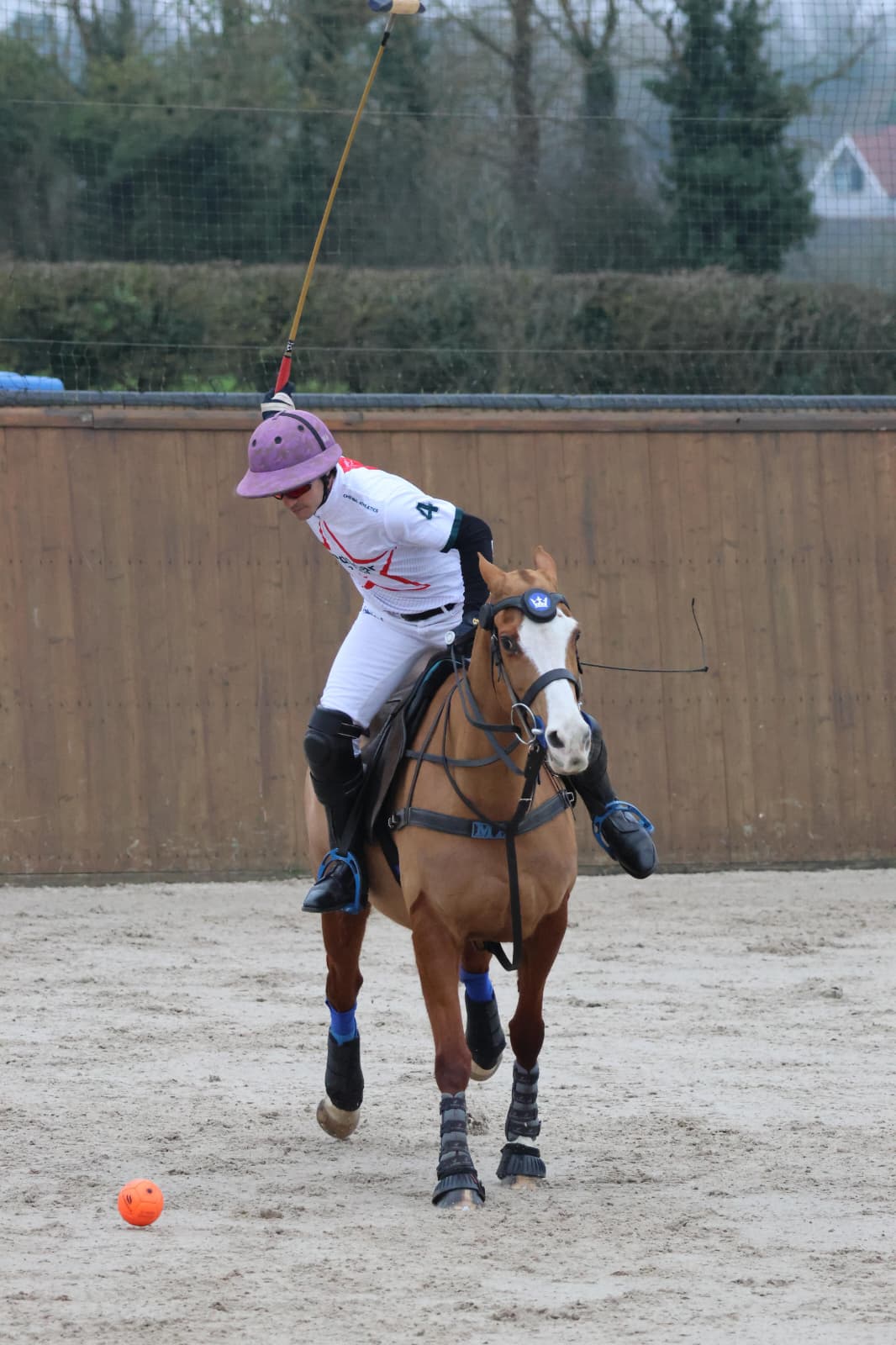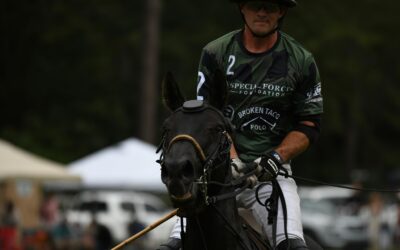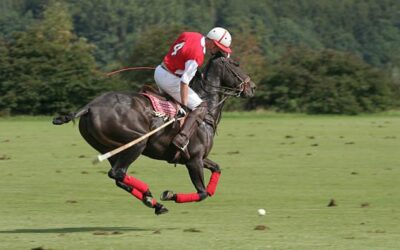Learning to handle the mallet for the first time requires attention and, above all, awareness of a series of details that will be fundamental forever. It’s not simply a matter of getting on a horse, taking a mallet, and starting to hit a ball—quite the opposite.
Let’s start with the most basic and important part: having a good position on the stirrups.
“Polo begins in the stirrups.”
-
THE PLATFORM
As in any sport—tennis, golf, baseball, to name a few—you need good positioning on the ground to develop a proper swing. In polo, the ground is represented by the stirrups.
We rest on the stirrups comfortably, using a high grip (adductors), middle grip (knees), and low grip (upper third of the calves). We place our weight on each stirrup, more toward the inner side, in a proportion that depends on the shot.
In the case of the drive—the most common forward shot on the mallet side (or “la del taco” as it’s called in Argentina)—our weight on the right stirrup should be about 80% compared to the left (the mounting side).
We adopt a platform position, meaning support on the right stirrup exactly as if we were standing on the ground, with a knee grip and an elevated position over the saddle, slightly off the horse’s midline or forward axis.
The opposite leg (left) acts as fixation and balance, gripping with the knee and keeping the foot elevated on the stirrup. This favors, as we will see, the rotation of hips and shoulders, both at the beginning and at the end of the swing.
Practicing this position at different horse paces gives us the foundation to start working with the mallet.
Exercises such as:
- “Place your hand, palm down, on the horse’s neck, between the ears,” simulating the end of the swing, and
- “Touch the star,” by raising your arm backward and upward, simulating the top of the swing (start of the mallet’s downswing),
help develop the range of motion required for a proper swing.
-
HOLDING THE MALLET (Grip)
Here begins the second stage of learning.
It’s essential to hold the mallet correctly. Each of the five fingers has a specific function, with the index finger and thumb being the most important for power and direction.
The way we hold the mallet by its grip or handle will also determine the movement of the wrist, forearm, and arm.
The development of the swing follows what we call the kinetic chain—a sequence of linked segments that starts at the stirrups and ends at the mallet head. The grip is the final link in this chain and one of the most crucial when directing the ball.
III. START OF THE SWING
From the platform position on the right stirrup, the rotation of hips and shoulders begins.
We aim to bring the mallet to the top of the swing by pointing toward the target with the left shoulder, while rotating the hips and shoulders clockwise.
The arm extends with the palm facing outward (supination), maintaining a 90° angle between the mallet and forearm—everything perfectly parallel to the horse’s forward axis.
After this backswing phase, the energetic downswing begins, keeping the 90° angle until pre-contact, where the arm aligns with the shoulder and the ball, and the mallet lags slightly—at about 45°, still in supination.
At this point, supination-pronation (the “snap”) occurs, achieving precise contact with the ball. This movement happens counterclockwise.
After impact, the hand, wrist, and forearm pronate, and everything transitions into balance and relaxation, completing the follow-through.
The swing ends with core torque, combined with the rotation of hips and shoulders, and the inertial follow-through of the mallet, with a relaxed, slightly open hand holding the mallet between thumb and index finger.
The little finger plays an important role—it controls the circular motion of the follow-through.
- TIMING
This is the most important and most difficult aspect to master, given the many factors involved:
- Speed of the horse
- Speed of the swing
- Distance to the ball
- Whether stationary or in motion
- Direction of movement (with or against the line)
- Type of ground or field condition
- Horse’s balance and stride quality
- Environmental factors, like strong wind or defensive pressure from an opponent
Contact with the ball must be solid, ideally just below its equator.
The point of impact is where the cigar (mallet head) lies flat on the ground, projected to the rider’s right knee, and occurs exactly as the horse’s leading foreleg (in this case, the right leg) lands.
At that instant, the other three legs lift from the ground, propelling forward—the accordion closes.
The exact distance between hand and ball is adjusted by flexing the knee and, to a lesser degree, the right hip.
EFFECTIVE, EFFICIENT, AND SUCCESSFUL STRIKES
We can say that an effective hit is efficient and successful.
An efficient hit is effective but not always successful, and an effective hit is not always efficient or successful.
Missing the ball may be the result of hitting without purpose.
If the hit has purpose, it is efficient.
If it fulfills its tactical role in a play, it is successful.
Once these steps and stages are completed, we can say we have developed a correct swing, ingrained in muscle memory—competent and unconscious.
Everything flows naturally, without tension or force.
Among the variations—full swing, half swing, and short tap—it’s very important to bring the mallet far back, make a small pause (allow the mallet’s inertia), and then move forward to contact the ball.
In other words, we give time for muscular transfer, first engaging the extensors and then the flexors.
Every swing should be performed with quality—what’s called the sporting gesture—meaning, not forced, with proper timing and precision.
Practice of the different swings is the key for them to become permanently embedded in muscle memory.
Eduardo A. Amaya








